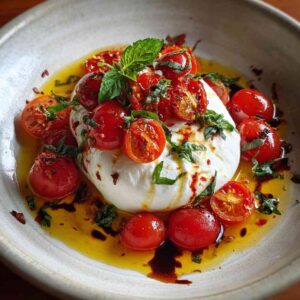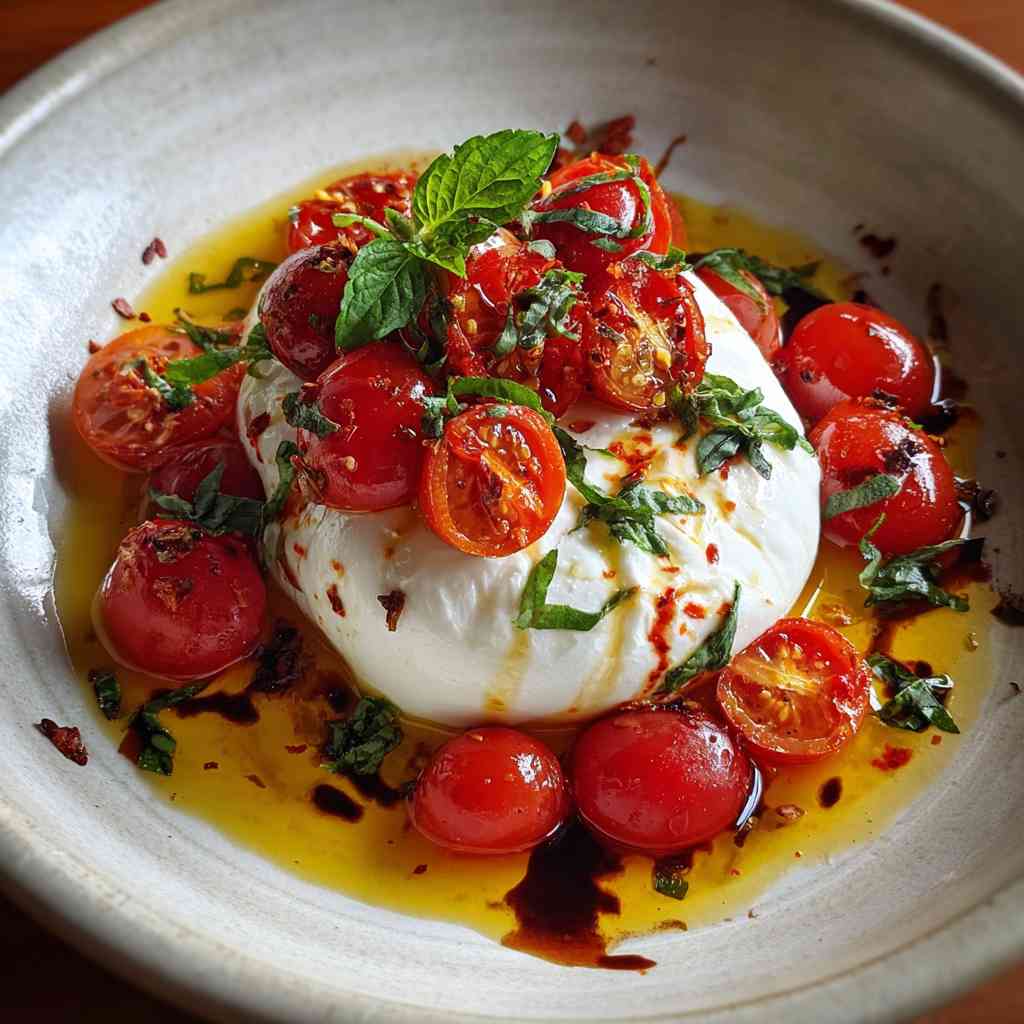Imagine sinking your fork into a perfectly creamy, slightly tangy burrata, the rich, velvety center oozing onto your plate. This Italian cheese, a relative of mozzarella, has become a beloved staple on restaurant menus and home kitchens alike. But did you know you can easily recreate this delectable delight in your own kitchen? Prepare to experience the ultimate in culinary indulgence with our Flavorful, Easy Burrata Recipe.
Burrata is a true labor of love, with a delicate outer shell encasing a luscious, soft interior. While it may seem intimidating to make at home, this recipe breaks down the process into simple, straightforward steps. By the time you’ve finished, you’ll have a stunning display of creamy, fresh burrata ready to grace your table and delight your guests.
Whether you’re a seasoned home chef or a novice in the kitchen, this recipe is designed to ensure your success. With just a few key ingredients and a bit of patience, you’ll be well on your way to creating a restaurant-worthy burrata that will have everyone raving. So, let’s dive in and uncover the secrets to making this irresistible cheese at home.
🥰 Why You’ll Fall in Love with This Recipe ?
Burrata is a true culinary gem, and this recipe showcases its best qualities. From the luscious, creamy interior to the delicate, stretchy outer shell, every bite will transport you to the heart of Italy. But what sets this recipe apart is the depth of flavor it offers.
By carefully selecting high-quality ingredients and employing a few clever techniques, we’ve elevated the classic burrata to new heights. The addition of fresh herbs and a drizzle of high-quality olive oil elevates the overall experience, creating a perfect balance of creaminess, tanginess, and herbaceous notes. And the best part? This recipe is surprisingly easy to execute, making it a go-to option for both special occasions and casual gatherings.
Ingredients
• 1 1/2 teaspoons (7.5 ml) citric acid or rennet
• 1 teaspoon (5 ml) salt
• 1/4 cup (60 ml) heavy cream
• 2 tablespoons (30 ml) chopped fresh basil
• 2 tablespoons (30 ml) chopped fresh parsley
• Extra-virgin olive oil, for drizzling
The key to this recipe is the quality of the ingredients, particularly the milk. Opt for the freshest, highest-quality whole milk you can find, as this will ensure a rich, creamy texture in the final burrata. The citric acid or rennet helps to coagulate the milk, creating the distinctive curds that will become the outer shell of the burrata. The heavy cream adds an extra layer of richness, while the fresh herbs provide a vibrant, aromatic finish.
Instructions
- Heat the Milk: In a large, heavy-bottomed pot, heat the whole milk over medium heat, stirring occasionally, until it reaches a temperature of 195°F (91°C).
- Curdle the Milk: Once the milk has reached the desired temperature, remove the pot from the heat and stir in the citric acid or rennet. Gently stir the mixture for 2-3 minutes, until the curds (solid milk solids) have separated from the whey (liquid).
- Drain the Curds: Using a slotted spoon, carefully transfer the curds to a colander, allowing the whey to drain off. Reserve the whey for another use, such as in baking or for feeding pets.
- Stretch and Shape the Burrata: Place the drained curds in a microwave-safe bowl and knead them gently to remove any excess whey. Microwave the curds on high for 30 seconds, then knead again. Repeat this process 2-3 times, until the curds become smooth and pliable. Gently stretch and shape the curds into a ball, creating a hollow in the center. Carefully pour the heavy cream into the center of the ball.
- Seal and Chill: Gather the edges of the burrata around the cream-filled center, sealing the ball to enclose the cream. Gently shape the burrata into a smooth, round form. Place the finished burrata in an ice bath and chill for at least 30 minutes, or until firm.
- Finish and Serve: Remove the chilled burrata from the ice bath and pat it dry with paper towels. Gently transfer the burrata to a serving plate and sprinkle with the chopped fresh basil and parsley. Drizzle with a generous amount of high-quality extra-virgin olive oil. Serve immediately and enjoy the creamy, flavorful delight!
Timing Overview
• Cook time: 10 minutes
• Chilling time: 30 minutes
• Total Time: 55 minutes
Nutritional Information
Nutritional information is an estimate per serving, based on 6 servings.
• Protein: 14 g
• Sodium: 410 mg
• Carbohydrates: 5 g
• Fat: 23 g
• Fiber: 0 g
💡 How to Customize This Recipe ?
• To Make it Vegan: Unfortunately, this recipe cannot be made vegan, as it requires the use of dairy products such as milk and cream.
• To Add a Spicy Kick: For a touch of heat, try adding a small amount of crushed red pepper flakes or finely chopped fresh chilies to the herb mixture before sprinkling it over the burrata.
🎉 Elevate Your Meal with These Serving Tips
• Garnish Suggestions: Garnish the burrata with a drizzle of high-quality balsamic glaze, a sprinkle of toasted pine nuts, or a few slices of prosciutto.
• Beverage Pairing: This creamy, flavorful burrata pairs wonderfully with a crisp, dry white wine, such as a Pinot Grigio or Sauvignon Blanc. For a non-alcoholic option, consider a refreshing sparkling water or a light, herbal iced tea.
❌ Common Mistakes to Avoid
• Mistake 2 – Using Cold Ingredients: It’s crucial that all the ingredients, including the milk and cream, are at room temperature before beginning the burrata-making process. Cold ingredients can affect the texture and prevent the curds from forming properly.
• Mistake 3 – Overheating the Milk: Be very careful not to overheat the milk beyond the recommended temperature of 195°F (91°C). Exceeding this temperature can cause the curds to become tough and rubbery, compromising the overall texture of the burrata.
🥡 Smart Storage for Maximum Flavor
• Freezing: Unfortunately, burrata does not freeze well, as the high moisture content can cause the texture to become watery and unpleasant upon thawing. For best results, enjoy your burrata fresh.
• Reheating: Burrata is best served at room temperature or chilled. If you need to reheat it, place the burrata in a warm oven (350°F/175°C) for 5-10 minutes, just until it’s slightly warmed through.
❓ FAQs
Can I use low-fat or skim milk to make burrata?
While it’s possible to make burrata with low-fat or skim milk, the results will not be as rich and creamy as when using whole milk. The high-fat content of whole milk is crucial for achieving the signature texture and mouthfeel of authentic burrata. For the best possible outcome, we recommend sticking with high-quality whole milk.
How can I tell if the burrata is fresh?
A fresh burrata should have a soft, pliable outer shell and a creamy, oozing center. When you gently press on the burrata, it should give slightly but maintain its shape. Avoid burrata that appears shrunken, wrinkled, or overly firm, as these signs indicate the cheese is past its prime.
Can I substitute lemon juice for the citric acid?
Yes, you can use lemon juice as a substitute for the citric acid in this recipe. The amount will be the same – 1 1/2 teaspoons (7.5 ml) of lemon juice can replace the citric acid. Keep in mind that lemon juice may impart a slightly more pronounced tanginess to the final burrata.
How do I know when the burrata is done stretching?
The perfect burrata should have a smooth, pliable texture that can be easily stretched and shaped. When the curds become silky and glossy, with no visible seams or cracks, they are ready to be formed into the final ball. Avoid over-stretching, as this can cause the burrata to become tough and rubbery.
Can I make burrata in advance?
For the best texture and flavor, it’s best to make burrata just before serving. The creamy interior and delicate outer shell are at their peak immediately after being formed. However, you can make the burrata up to 3 days in advance and store it in the refrigerator, as long as it’s kept in an airtight container.
💌 Enjoy Your Delicious Creation!
Congratulations! You’ve just mastered the art of making delectable, restaurant-quality burrata in your own kitchen. This recipe is a true labor of love, but the end result is so worth it. Whether you’re serving it as a sophisticated appetizer or incorporating it into a larger meal, your guests are sure to be impressed by the creamy, flavorful burrata you’ve created.
As you savor each bite, take a moment to appreciate the care and attention that went into this dish. The perfectly stretched outer shell, the luxurious cream center, and the fragrant herbs all come together to create a truly unforgettable culinary experience. Enjoy your burrata with a glass of crisp white wine, a drizzle of premium olive oil, and the knowledge that you’ve mastered a true Italian classic.
Happy cooking, and bon appétit!

Flavorful, Easy Burrata Recipe
⏱️ Timing Overview
🥘 Ingredients
📝 Instructions
- In a large, heavy-bottomed pot, heat the whole milk over medium heat, stirring occasionally, until it reaches a temperature of 195°F (91°C).
- Once the milk has reached the desired temperature, remove the pot from the heat and stir in the citric acid or rennet. Gently stir the mixture for 2-3 minutes, until the curds (solid milk solids) have separated from the whey (liquid).
- Using a slotted spoon, carefully transfer the curds to a colander, allowing the whey to drain off. Reserve the whey for another use, such as in baking or for feeding pets.
- Place the drained curds in a microwave-safe bowl and knead them gently to remove any excess whey. Microwave the curds on high for 30 seconds, then knead again. Repeat this process 2-3 times, until the curds become smooth and pliable. Gently stretch and shape the curds into a ball, creating a hollow in the center. Carefully pour the heavy cream into the center of the ball.
- Gather the edges of the burrata around the cream-filled center, sealing the ball to enclose the cream. Gently shape the burrata into a smooth, round form. Place the finished burrata in an ice bath and chill for at least 30 minutes, or until firm.
- Remove the chilled burrata from the ice bath and pat it dry with paper towels. Gently transfer the burrata to a serving plate and sprinkle with the chopped fresh basil and parsley. Drizzle with a generous amount of high-quality extra-virgin olive oil. Serve immediately and enjoy the creamy, flavorful delight!

